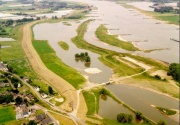Difference between revisions of "Gameren"
(→Introduction) |
(→Introduction) |
||
| Line 53: | Line 53: | ||
[[Image:Gameren_Oblique_view.jpg|thumb|left|View on side channel set of Floodplain "Gameren", downstream direction. Photo: Rijkswaterstaat (NL)]] | [[Image:Gameren_Oblique_view.jpg|thumb|left|View on side channel set of Floodplain "Gameren", downstream direction. Photo: Rijkswaterstaat (NL)]] | ||
| − | <p> | + | <p>Under the authority of the Ministry of Transport, Public Works and Water Management (Eastern Netherlands division), the Institute for Inland Water Management and Waste Water Treatment RIZA executed a monitoring program on secondary channels in the Gamerensche Waard. During the period 1996-2002 a broad and complete program was executed with three main objectives: 1) evaluation of the desired effects, 2) assessment of the undesirable side-effects (risks) and 3) increase of the knowledge about secondary channels.</p> |
| − | + | <p>In the period 1995-1999 three secondary channels were excavated in the Gamerensche Waard along the river Waal (the main side branch of the river Rhine). Regarding the dimensions, these channels are unique for Dutch rivers. These channels are digged out partly from former agricultural grassland and partly they ecxists of connected former sand and clay exctraction pits. The three secondary channels vary with regard to location (inside and outside the summer embankment), length (0.5-2 km), width, depth (0-20 m), discharge (1-3%) and the like. Just one of the channels is flowing permanently, the other two | |
| + | contain flowing water in respectively 4 and 11 months a year.</p> | ||
==References== | ==References== | ||
Revision as of 13:31, 7 May 2009
Gameren
Introduction
Under the authority of the Ministry of Transport, Public Works and Water Management (Eastern Netherlands division), the Institute for Inland Water Management and Waste Water Treatment RIZA executed a monitoring program on secondary channels in the Gamerensche Waard. During the period 1996-2002 a broad and complete program was executed with three main objectives: 1) evaluation of the desired effects, 2) assessment of the undesirable side-effects (risks) and 3) increase of the knowledge about secondary channels.
In the period 1995-1999 three secondary channels were excavated in the Gamerensche Waard along the river Waal (the main side branch of the river Rhine). Regarding the dimensions, these channels are unique for Dutch rivers. These channels are digged out partly from former agricultural grassland and partly they ecxists of connected former sand and clay exctraction pits. The three secondary channels vary with regard to location (inside and outside the summer embankment), length (0.5-2 km), width, depth (0-20 m), discharge (1-3%) and the like. Just one of the channels is flowing permanently, the other two contain flowing water in respectively 4 and 11 months a year.
